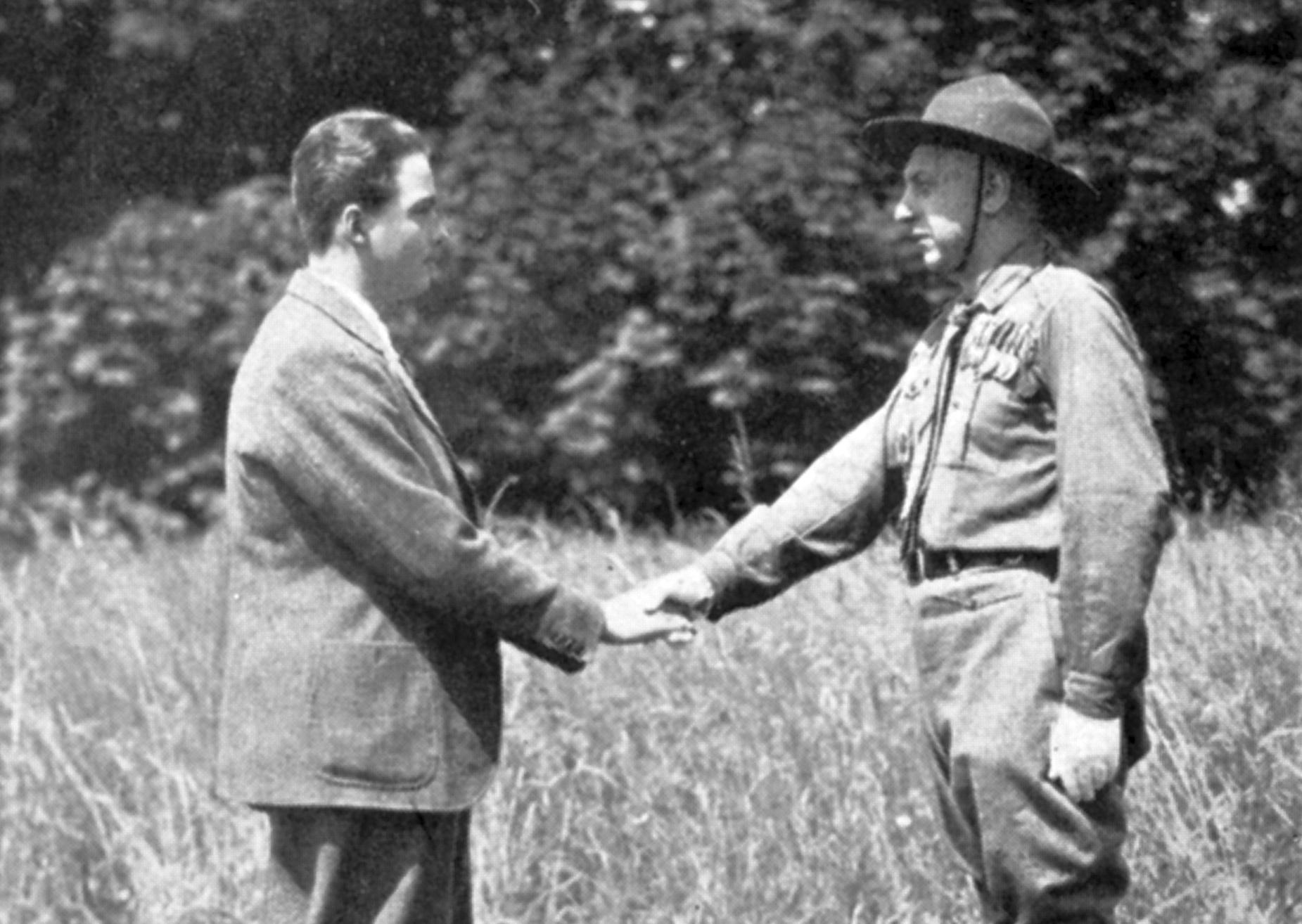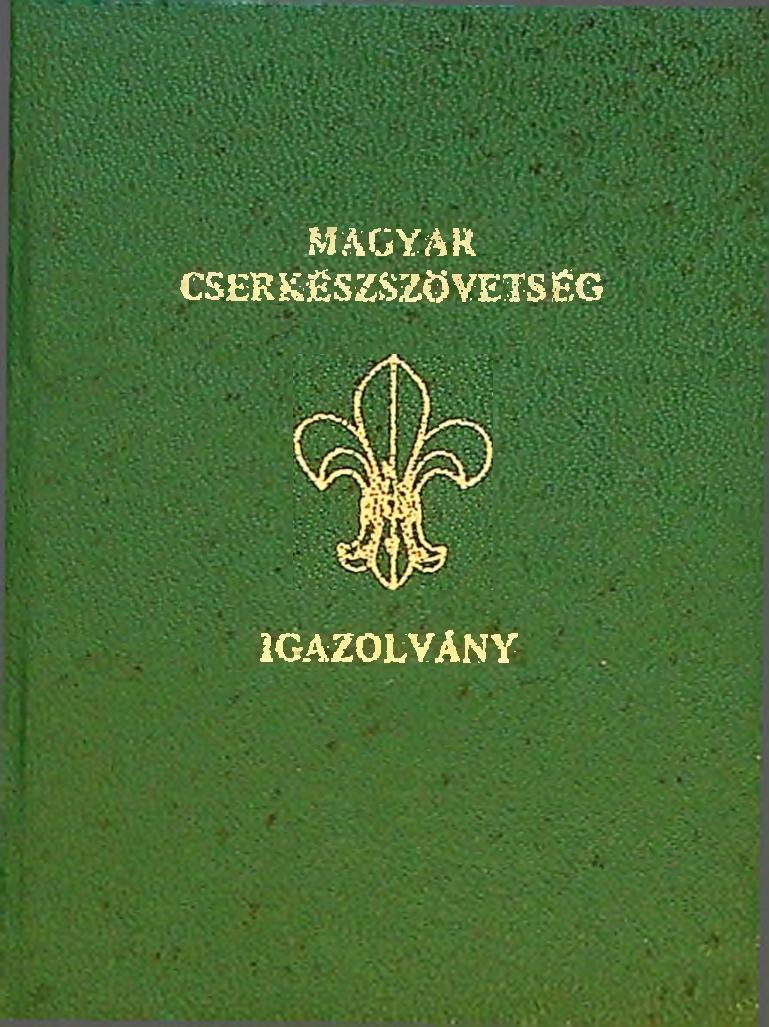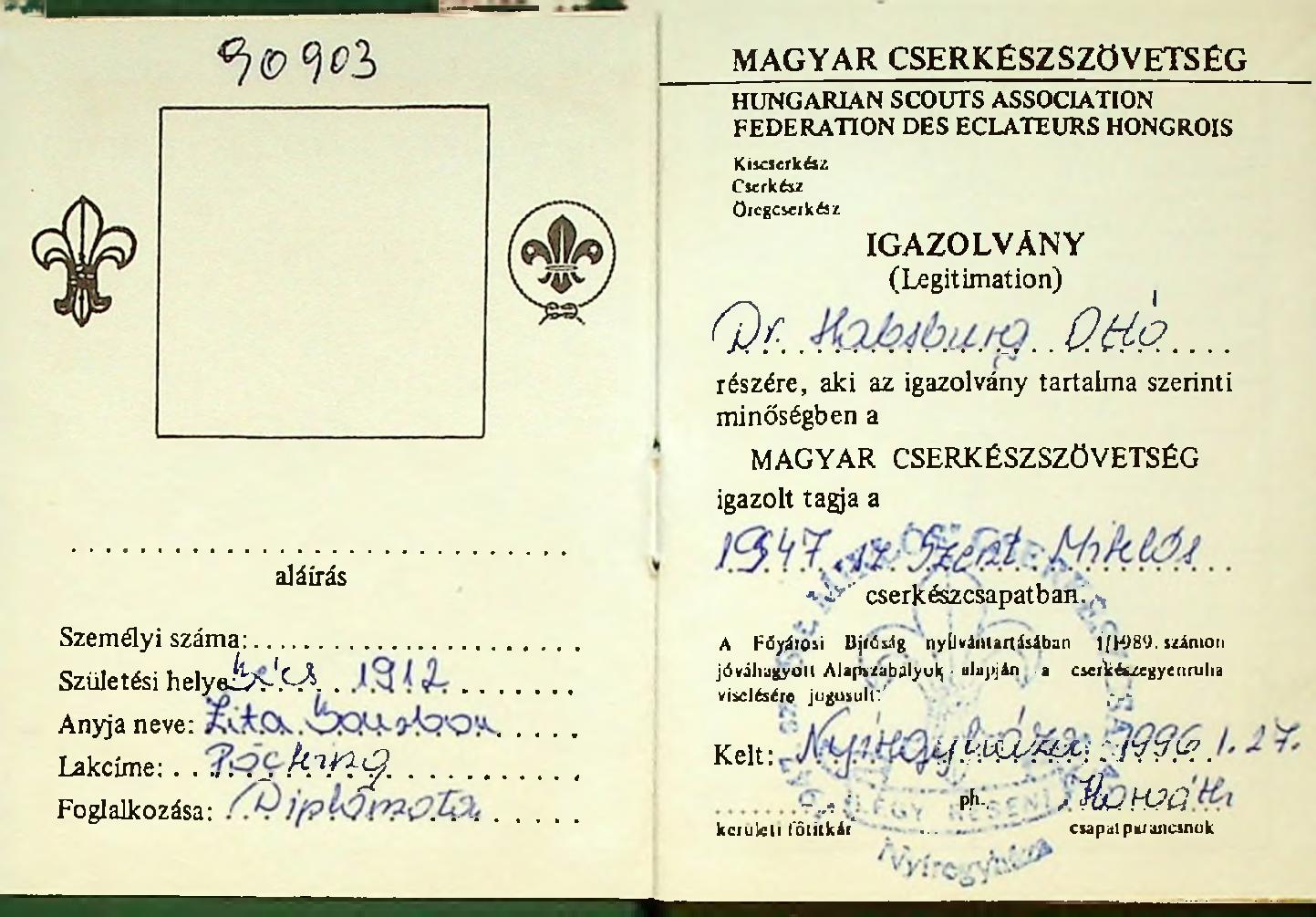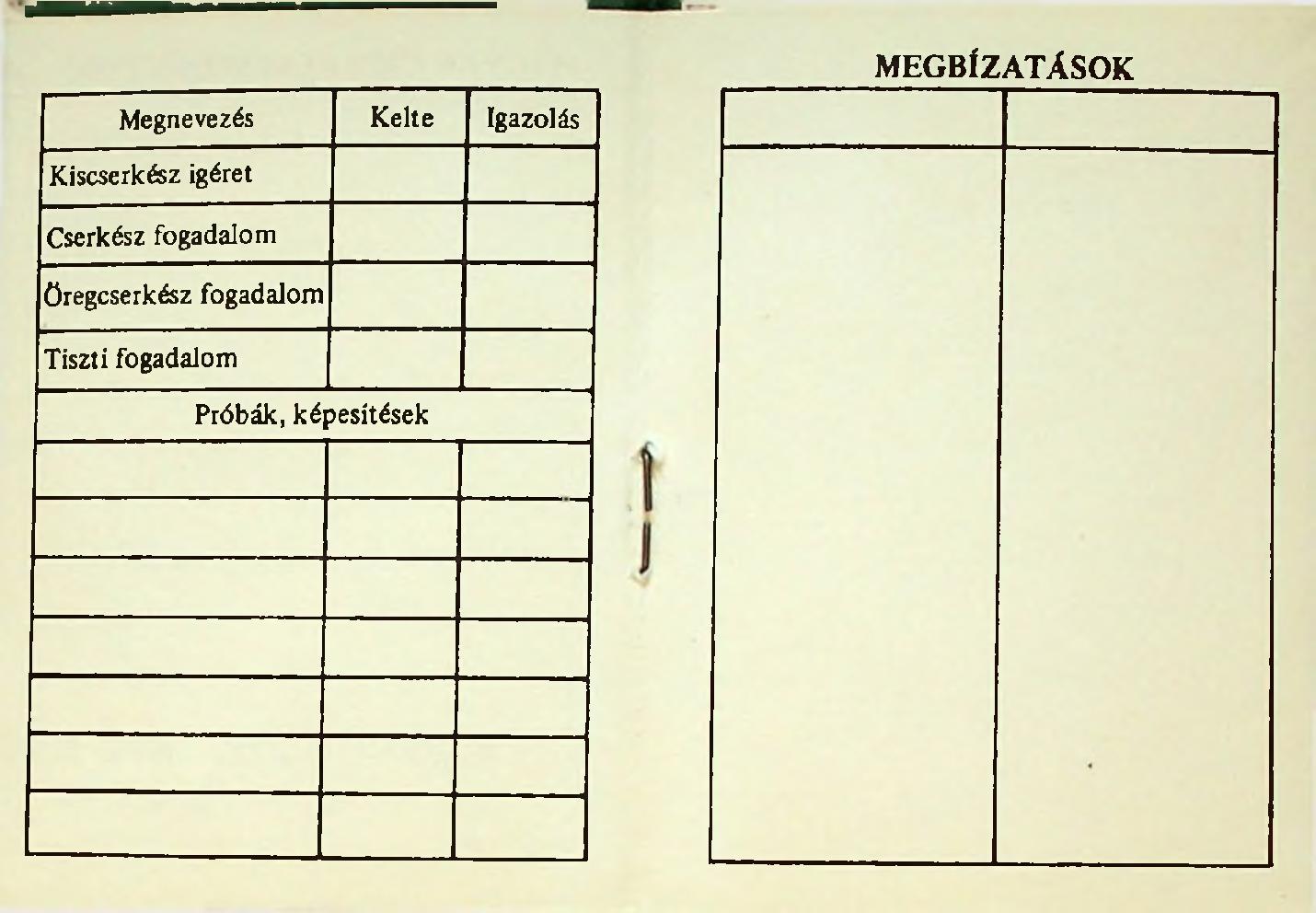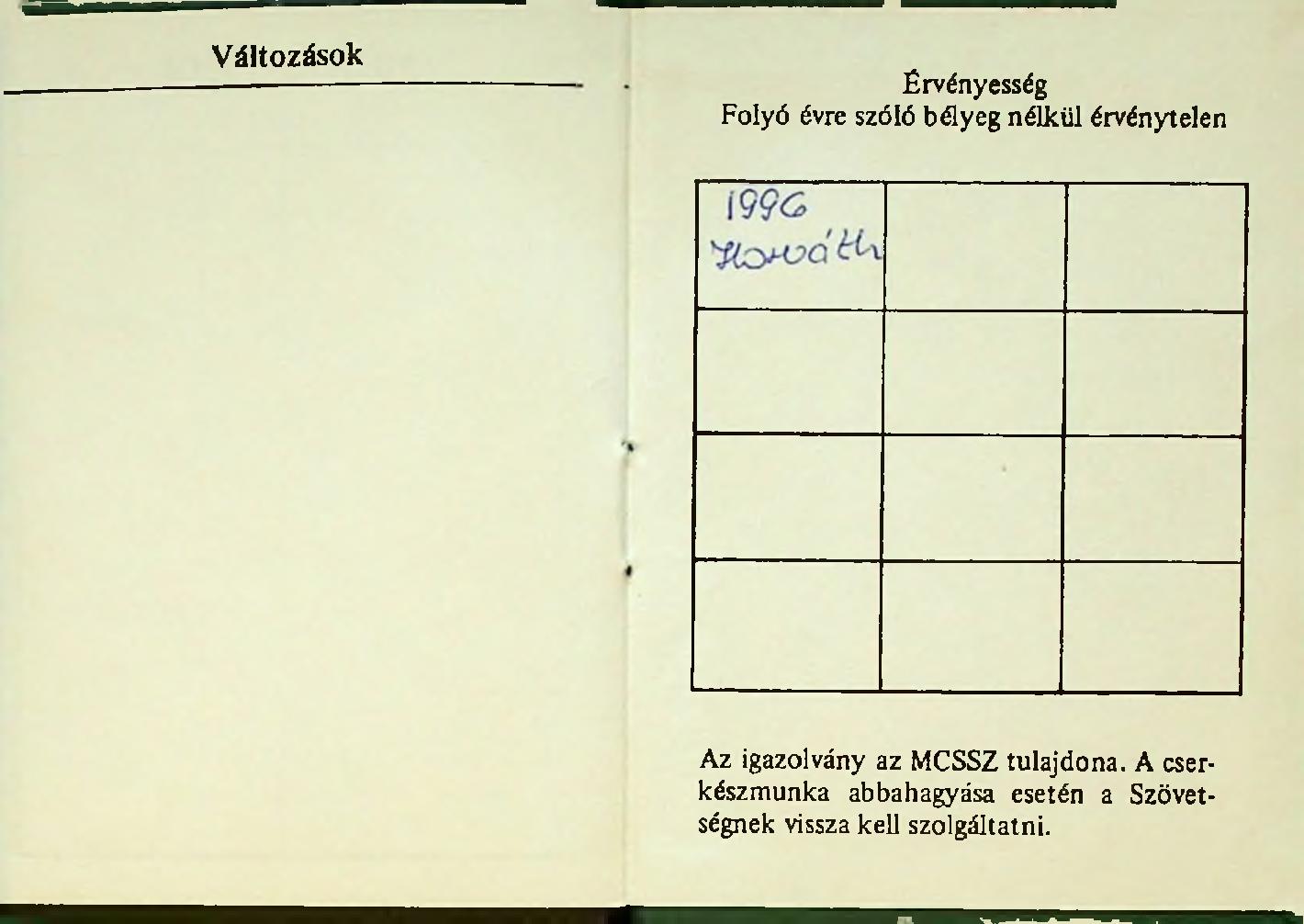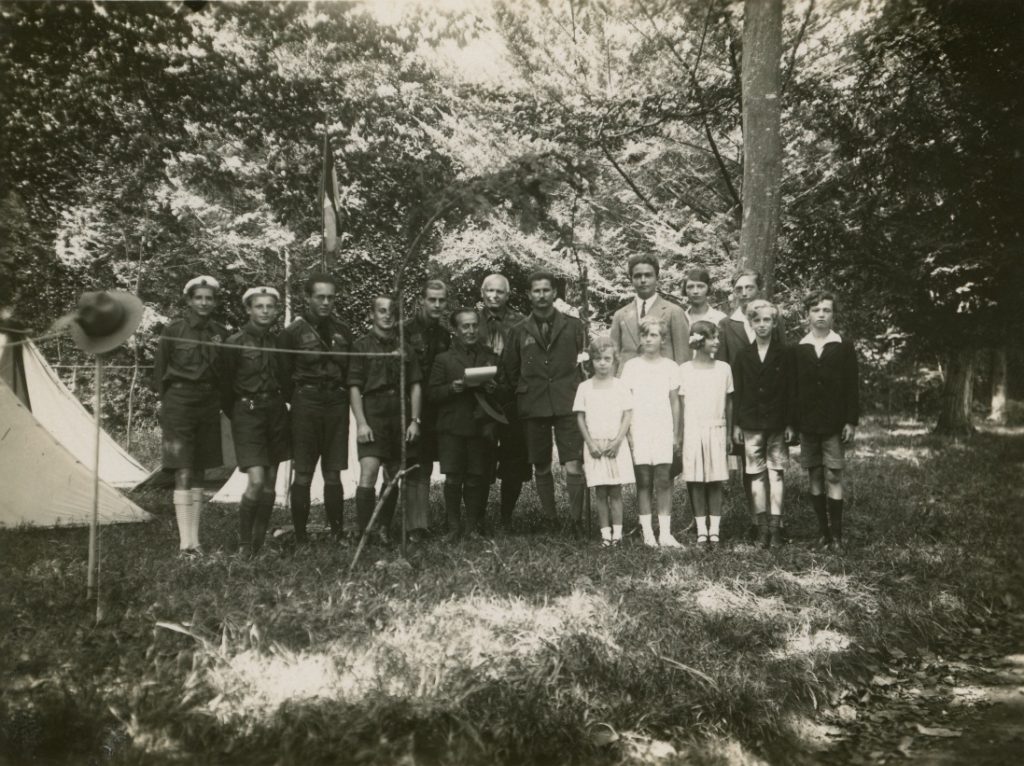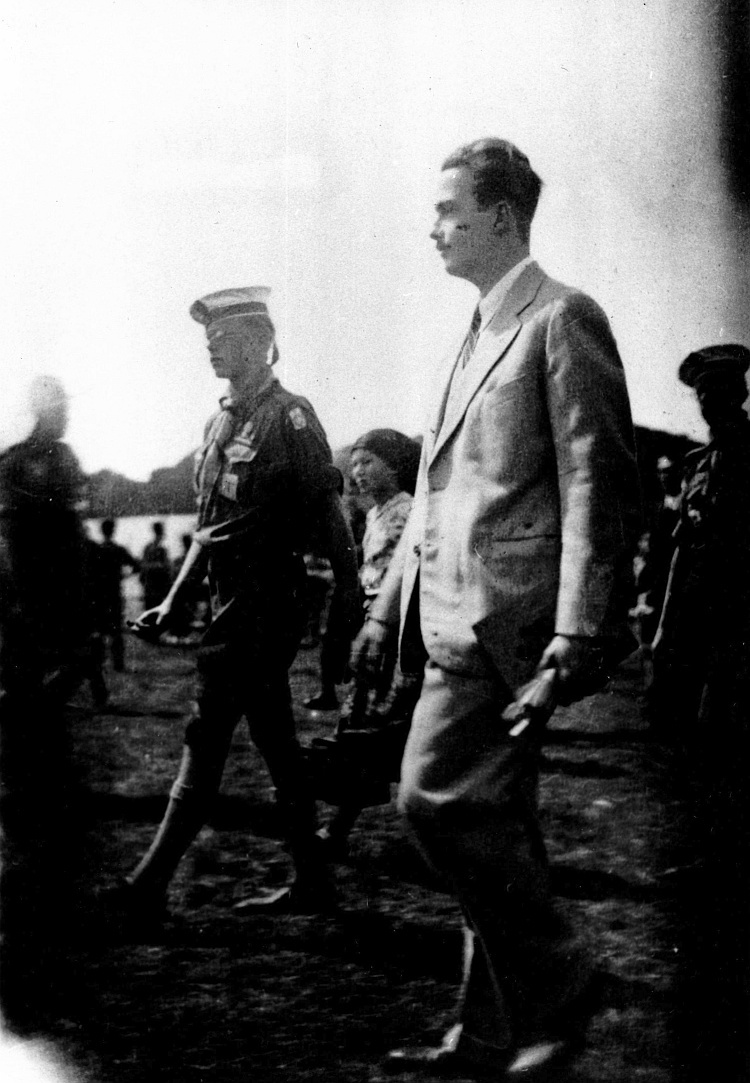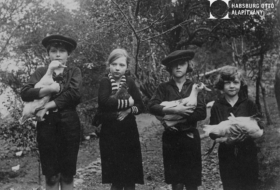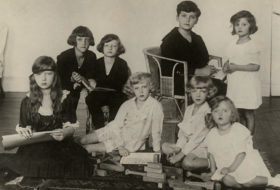The life of Otto von Habsburg is well-known to many people due to his personal testimonies, biographies and the articles written about him. Our Foundation aims to add new details to this topic through the very colourful legacy in our care.
Our photo collection and archival material provide several references to the relationship between the Archduke and scouting. The world meeting of this important and famous youth movement was held in Gödöllő ninety years ago.[1] The so-called 4th World Scout Jamboree, which was held from 1 to 15 August 1933, and was one of the most notable events in Hungary and internationally between the two world wars, was not attended by Otto von Habsburg, who was a student at the Catholic University of Leuven at the time. However, he was present at the subsequent meeting in the Netherlands in 1937.[2]
It was exactly thirty years ago, in July 1993, that an international scout camp was held in Dénesfa, in the county of Győr-Moson-Sopron, where Gusztáv Jäckel, leader of #364 Scarbantia Scout Troop, asked the eponym of our Foundation to become its patron.[3] In our collection we hold the Scout Certificate issued to the Archduke on 27 January 1996 in Nyíregyháza.[4] According to the – albeit incomplete – document, Otto von Habsburg is a certified member of the Hungarian Scout Association in the #1947 Szent Miklós {Saint Nicholas} Scout Troop. In addition to these surviving artefacts, it is mainly from the documents that we can learn about the role that scouting played in the life of Otto von Habsburg.
1. Certificate issued by the Hungarian Scout Association to Otto von Habsburg
In a letter dated 16 September 1995, Otto von Habsburg confessed that he had been intrigued by scouting since childhood and the positive influence it had on young people.[5] From a young age, the former heir to the throne often met several members of the youth movement founded by Baden-Powell. A significant event for him was when he was visited by Hungarian scouts in Spain. This encounter is recorded in Kálmán Radványi’s literary book entitled Cserkészúton Spanyolföldön {On Scout Trip in Spanish Land}. The young-adult fiction writer, who was popular between the two world wars, was himself a scoutmaster. One of the settings of his multi-published book is Lekeitio, the Basque fishing village where the royal family lived in the 1920s. The story goes that, after the conclusion of the 3rd Jamboree in England in 1929, the leader of the Hungarian team, the Benedictine monk Dr Kasszián Mattyasovszky, separated from the troop along with a few boys to attend the Spanish national camp in Barcelona. During their trip they visited, among others, Otto von Habsburg and his family.[6] According to the Magyar Cserkész {Hungarian Scout} magazine, „a particular sensation is the part of the book in which the Hungarian scouts describe their meeting and time spent with the royal family”.[7]
Scouts in Lekeitio, 1929
Later this article was sent to Otto von Habsburg. In a letter dated 7 January 1991, the former heir to the throne wrote that he was delighted with this chapter of the book, which reminded him of fond old memories.[8] The meeting with the scouts is also mentioned in the biography written by Emil Csonka, a close associate of Otto von Habsburg.[9] The book mentions, among other special adventures in Lekeitio, that the Crown Prince climbed out of the window to join the „troop of scouts from home” who serenaded him.[10] This event, recalled by many, is described by Otto von Habsburg himself in his 1981 article on the scouts as follows: „With my mother and my brothers and sisters, we lived within the walls of the Basque fishing village of Lequeitio, on the Atlantic coast at the foot of the Pyrenees. And then suddenly, a Hungarian scout troop came to visit us from along the Danube, and boys and girls my age and I had a bonfire in the garden of our house, and that evening I felt at home again in the landscape of my childhood, at home in Gödöllő, playing again in spirit with my old friends.” [11]
There is photographic records of Otto von Habsburg’s personal presence at the aforementioned World Scout Jamboree in the Netherlands.[12] Although the Archduke did not attend the meeting in Gödöllő, his correspondents sent him several pictures of the event. The Jamboree in the Netherlands was the last one held before the Second World War, and it was also the last meeting attended by Robert Baden-Powell, the founder of Scouting. The August 1937 report of the legitimist daily newspaper Új Nemzedék {New Generation} made special mention of the presence of the 25-year-old heir to the throne, stating that „the most outstanding event of the camp was the visit of King Otto II (sic!)”.[13] We also found information about this meeting in the correspondence of Otto von Habsburg. Two letter-writers surprised the Archduke with photographs they had taken themselves in 1987 and 1990.[14] In his letter of thanks, Otto von Habsburg wrote: „I remember fondly and very well the jamboree in Vogelenzang, which I attended with Count Teleky (sic!).[15] During the Second World War, many of my personal memorabilia had been lost, so I was particularly pleased to receive the photographs you sent me.”[16] Indeed, Otto von Habsburg’s figure cannot be omitted from the published accounts of the 5th World Scout Jamboree. One example of this is the article written by Dr. Endre Bánk, which appeared on the front page of the Keszthelyi Hírlap in February 1990.[17] At the meeting, which had an informal atmosphere, the Archduke won over the participants – mostly Hungarians – primarily with his language skills and friendly attitude.
Otto von Habsburg at the 5th World Scout Jamboree in the Netherlands
Throughout his life, Otto von Habsburg always paid close attention to scouting and was in contact with many people who were well known in the Scout Movement. He exchanged letters over many years with the conservative Swedish writer Arvid Fredborg, who was a scout himself, and with Friedrich von Perko-Greiffenbühl, who was associated with the organisation called Europa Scouts.[18] In Hungarian context, among others, we can mention György Kölley[19], a Catholic priest who led a scout troop in Munich.[20] In the summer of 1970, György Kölley and fellow officers from the European Jubilee Camp in Stockholm welcomed Otto von Habsburg.[21] This gesture shows that the leaders of the Scout Movement were counting on Otto von Habsburg. Another noteworthy example is Count János Hoyos, former President of the Hungarian Scout Association, who also maintained close ties with the former heir to the throne.[22] In a letter to János Hoyos dated 26 March 1981, Otto von Habsburg wrote that he felt very reassured that the presidency of the Council of the Scout Association was in the hands of the Count.
2. Letter from György Kölley to Otto von Habsburg, 1985
2. számú kép HOAL I-2-b-Kölley György 1985
3. György Kölley and fellow officers greeting Otto von Habsburg, 1970
3. számú kép HOAL I-2-b-Szabó Ödön 1970
Further information regarding scouting can also be found in Otto’s correspondence with Prince-Primate József Mindszenty. In 1972 the Church leader sent him a report on the activities of the Hungarian Scout Association in 1971. In his reply, the Archduke stressed that he was very pleased that the Primate was cooperating with the Scouts.[23] After 1989, Otto von Habsburg was invited to numerous scouting programmes in various places in Hungary, and he himself wrote many letters of greeting to the leaders of the reborn movement.[24] Some examples of his participation in scouting events can be found in the Hungarian-related correspondence. In 1989, according to the letters, he was even offered the rank of Chief Scout, although he eventually refused to accept it because he could not actually take on practical tasks.[25] In 1996, to commemorate the 1100th anniversary of the Hungarian conquest of the Carpathian Basin, the scouts organised a memorial camp in Nyíregyháza, and asked Otto von Habsburg to be the international patron of the event. He gladly agreed to this and wrote the following in his reply letter to István Horváth Jr., camp organizing officer: „I am very happy that the Scouts, a movement that has been of great value to our nation, are ready to organise a commemorative camp in the easternmost county to commemorate the 1100 years that the Hungarians spent in the Danube basin.”[26] It was in this spirit that in March 2002 he unveiled the Scout flag on Dugonics Square in Szeged.[27]
Otto von Habsburg repeatedly stressed how positive he considered the Scout Movement to be in the life of the Hungarian nation. „I know from long experience what a great value the Scout Movement is to our society”, wrote Otto von Habsburg, nearly 90 years old, on 12 March 2002 in Kassa, when celebrating the 10th anniversary of the local Ferenc Rákóczi II Scout Troop’s initiation.[28] Scouting, he believed, served clearly defined, concrete goals, objectives that he himself valued in his work. Such as the reconciliation of the peoples of the Danube basin, the building of international relations and educating young people. He also saw the Scout Movement as an important means of preserving the Hungarian language in the emigrant community.[29]
Otto von Habsburg summarised his appreciation of the identity preserving activity of scouting in his publication entitled Magyar cserkészek örök missziója {The Eternal Mission of the Hungarian Scouts}.[30] The article is preserved in the archives of the Otto von Habsburg Foundation.
Eszter Gaálné Barcs
[1] The Jamboree Camp Chief was Count Pál Teleki, who had been Prime Minister at the time when Otto von Habsburg’s father, Charles IV, had sought to reclaim the throne of Hungary in 1921 (the attempt is also known as the Easter Royal coup d’état). The connection between Otto von Habsburg and the Jamboree in Gödöllő is that the #560 King Charles IV (later András Jelky) Scout Troop of Baja participated in the World Meeting. On May 7, 1933, the widowed Queen Zita was “mother” of the flag at the troop’s flag dedication ceremony. (In the old days, it was common to appoint a lady to officiate at a ceremonial flag-raising, usually a female relative of a state, municipal or military leader.) György Cserba: 560. IV. Károly Király Cserkészcsapat Emlékei Baja, 1991. (fényképalbum) {Memories of the #560 King Charles IV Scout Troop of Baja, 1991 (photo album)} HOAL I-5-b 9-36; Keresztény Élet, 20April 1997, p. 8
[2] The leader of the Hungarian scouts was the Chief Scout of Hungary, Count Pál Teleki.
[3] HOAL-I-2-c-Jäckel Gusztáv 16 March 1993
[4] See picture no. 1
[5] HOAL-I-2-c-Gyetvay-Grivičič Iván 16 September 1995
[6] Kasszián Mattyasovszky: Az angliai cserkészjamboree a mi szempontunkból. {The Scout Jamboree in England from our point of view.}; Pannonhalmi Szemle, 1929, 1, p. 580—587
[7] Magyar Cserkész {Hungarian Scout}, 1930, p. 23. The fifth chapter of the book, entitled Warm-eyed Mother, Eight Orphans, is about the encounter between the boy scouts and the royal family.
[8] HOAL-I-2-c-Boromisza Tamás 7 January 1991
[9] Emil Csonka: Habsburg Ottó. Egy különös sors története. {Otto von Habsburg: A Story of a Peculiar Fate}. Új Európa, Munich, 1972, p. 132
[10] Ibid. p. 132
[11] HOAL-I-2-b-Hoyos János 1981. The royal family visited Gödöllő on 23 October 1918. The visit is described in the Historia Domus of the Roman Catholic Parish of Gödöllő. The source records that the royal family had a very good time. Special mention is made of the kindness of the little heir to the throne and the fact that the King spoke only Hungarian. VPKL Gödöllő Historia Domus 1914-1995, p. 33
[12] The photograph owned by the Photo Archive of MTI Zrt. can be viewed HERE. (Date of download: 21 June 2023)
[13] Új Nemzedék, 6 August 1937, p. 7
[14] HOAL-I-2-c-Farkas János 8 June 1990, HOAL-I-2-b-Dr. Dolányi Kovács Géza 9 September 1987
[15] Count Pál Teleki
[16] HOAL-I-2-b-Dr. Dolányi Kovács Géza 9 September 1987
[17] Keszthelyi Hírlap, 2 February 1990, p. 1
[18] The correspondence over the decades between Arvid Fredborg and Otto von Habsburg is preserved in our Foundation’s archives. The extensive exchange of letters contains a wide variety of content. Arvid Fredborg was an active participant in Otto von Habsburg’s networking activities.
[19] Called „Uncle Gyurka” in scouting circles. Új Európa, 1982, 1, p. 19
[20] See picture no. 2 HOAL-I-2-b-Kölley György 25 December 1985
[21] See picture no. 3 HOAL-I-2-b-Szabó Ödön 1970
[22] Count Dr. János Hoyos (1915-2003), who had survived the Concentration Camp in Recsk, emigrated after the Hungarian Revolution of 1956 and worked as a doctor in New York. He was the leader of the Hungarian Order of Malta in America and an active organizer of Hungarian scouting. http://www.magyarkronika.com/magazin/0219.htm
[23] HOAL-I-2-b-Mindszenty József 26 May 1972
[24] On 27 January 1989 he welcomed the rebirth of the Hungarian Scouting, in particular the Scouting in Pécs. Pécsi Szemle, 2002, p. 75
[25] HOAL-I-2-c-Falus Ottó 20 March 1989
[26] HOAL-I-2-c-ifj. Horváth István 12 January 1996
[27] Délmagyarország, 4 March 2002, p. 1
[28] HOAL-I-2-c-Csajka Tamás 12 March 2002
[29] Habsburg Ottó: A 21. évforduló {Otto von Habsburg: The 21st Anniversary}. Új Európa, 1977, 6, p. 5
[30] Magyar világ {Hungarian world}. Új Európa, 1982, 1, p. 19
